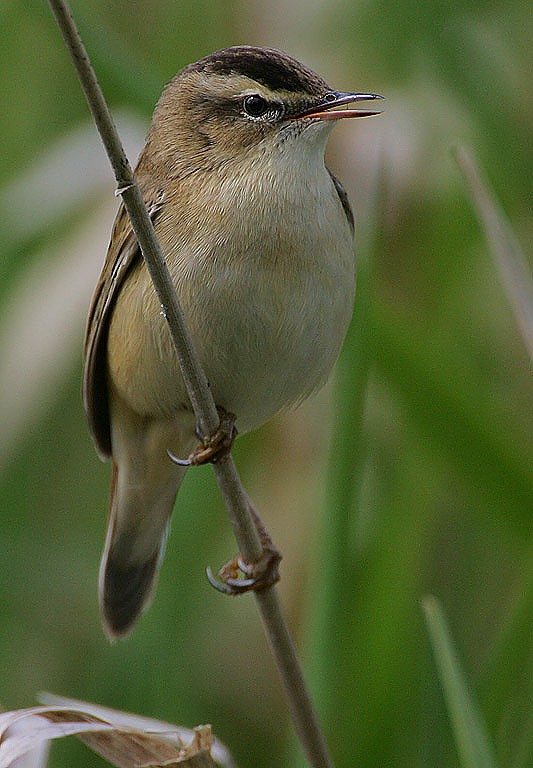Sedge Warbler
A species of Reed-warblers Scientific name : Acrocephalus schoenobaenus Genus : Reed-warblers
Sedge Warbler, A species of Reed-warblers
Botanical name: Acrocephalus schoenobaenus
Genus: Reed-warblers
Content
Description General Info
 Photo By Steve Garvie , used under CC-BY-SA-2.0 /Cropped and compressed from original
Photo By Steve Garvie , used under CC-BY-SA-2.0 /Cropped and compressed from original Description
The sedge Warbler is often easier to hear than it is to see. This small warbler has a long, fast-paced sound that identifies its presence in marshy habitats, where it prefers hiding in the bushes and reeds. The songbird is most active at dawn and dusk when it forages for insects and berries.
Size
13 cm
Colors
Brown
Gray
Life Expectancy
7 years
Nest Placement
Shrub
Feeding Habits
Sedge Warbler consumes a varied diet including insects like mayflies and beetles, as well as berries. They exhibit feeding behaviors such as 'picking' and 'leap-catching' in low vegetation. Before migration, sedge Warbler indulges in aphids to double their weight, aiding in long non-stop flights.
Habitat
Sedge Warbler chiefly inhabits moist environments near water bodies, such as marshes, riverbanks, and swamps with dense vegetation. They adapt to a variety of climates across boreal, temperate, Mediterranean, and steppe zones, preferring areas with cover like low shrubs and reeds. During the non-breeding season in Africa, sedge Warbler occupies diverse wetlands up to 2,500 meters, including marshy rainforest regions and bushlands.
Dite type
Insectivorous
General Info
Feeding Habits
Bird food type
Bird Feeder Type

Platform
Sounds
Call
Recording location: Belgium
Song
Recording location: Belgium
Song
Recording location: Netherlands
Song
Recording location: Netherlands
Distribution Area
The sedge warbler has a large range and an estimated Global Extent of Occurrence of 10 million square kilometres, with a large global population including between 8.8 million and 15 million birds in Europe. Data analysis by the British Trust for Ornithology has shown that fluctuations in the sedge warbler population stem from the adult survival rate, due to changes in rainfall on the birds' wintering grounds. Global changes in population have not been measured, but the sedge warbler's status is designated 'of least concern' by BirdLife International. It breeds across Europe and western and central Asia and is migratory. After feeding up post-breeding, they migrate quickly across southern Europe and the Sahara from August to September. Studies in Nigeria and Uganda suggest that sedge warblers return to spend winter at the same sites, year after year. All sedge warblers spend winter in sub-Saharan Africa, from Senegal in the west to Ethiopia in the east, and as far south as the eastern Cape Province of South Africa and northern Namibia. The route taken on the southward migration, and eventual wintering grounds, correspond to the birds' breeding grounds. Birds ringed in the United Kingdom and Netherlands are later found from south-west Iberia to Italy; birds from Sweden are recovered in central Europe and Italy; while Finnish birds are found in north-east Italy and Malta east to the Aegean region. Sedge warblers from the former Soviet Union take routes via the eastern Mediterranean Sea and Middle East. Loss of wetland areas for feeding on migration, and the expansion of the Sahara desert, pose threats to the sedge warbler's breeding population. Birds begin leaving Africa in late February, fatten up at wetlands before and probably after crossing the Sahara, and arrive in Europe from March onwards. Unlike other members of the Acrocephalus genus, the sedge warbler's range stretches from the Arctic to mid-latitudes. It is adapted to cool, cloudy and moist conditions. Though it is often found in wetlands, it can breed 500 metres or more away from water. During the breeding season, this is a species found in reedbeds, often with scrub, ditches and habitats away from water including hedgerows, patches of stinging nettles, and arable crops. On the African wintering grounds, habitats such as reeds at wetlands, papyrus, grass, sedge and reedmace and tall elephant grass are used. It can be found at altitudes of 1,800–2,400 metres above sea level in Ethiopia. 
Species Status
Not globally threatened.
Scientific Classification
Phylum
Chordates Class
Birds Order
Perching birds Family
Reed warblers Genus
Reed-warblers Species
Sedge Warbler